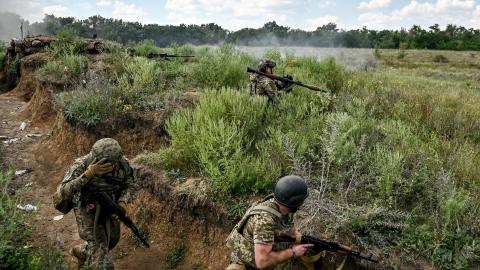Since Russia invaded Ukraine for the second time in eight years, Russian troops have ravaged Ukraine’s cities, raped its women, and stolen its children. Russian missiles and Iranian drones strike Ukrainian cities daily, often hitting civilian targets. Russia is the aggressor. Ukraine is the victim.
For Americans who believe in respect for national borders, the primacy of national sovereignty, and the right to self-defense, support for Ukraine is natural. Ukrainians are not asking for, nor do they want, US troops to help them fight Russia. All they ask for are the material resources that give them a fighting chance. Meanwhile, Russia is America’s top geopolitical adversary.
As Congress debates additional support for Ukraine, the anti-Ukraine echo chamber will peddle myths and half-truths, including these four:
Myth: Washington is writing Kyiv “blank checks” that Americans cannot afford.
Reality: Every dollar spent in support of Ukraine is authorized by Congress and used for a specific purpose. There has never been a “blank check” to Ukraine. As of September 2023, the US has provided Ukraine with $101 billion, or about 0.43 percent of America’s GDP. Since February 2022, this averages out to 68 cents per day for each American adult. The vast majority of this money never leaves the US and instead supports American jobs. For this modest amount, the US helps Ukraine dismantle Russia’s military without a single American firing a shot or being shot at. The US can easily afford to support Ukraine, but it cannot afford not to.
Myth: There is not enough oversight of US aid to Ukraine.
Reality: There has likely never been more accountability in place for US foreign assistance than what is available for Ukraine aid. Soon after Russia’s invasion, the US government established the Ukraine Oversight Interagency Working Group. More than 160 officials across 20 federal oversight agencies monitor US aid to Ukraine. To date, Congress has allocated $50 million for the Inspectors General of the Department of Defense, Department of State, and USAID to increase oversight through the working group. Dozens of reports have been completed with dozens more in the works. According to the working group, “Investigations related to the Ukraine response have not yet substantiated significant waste, fraud, or abuse.”
Myth: America is exponentially the largest donor to Ukraine.
Reality: According to the Kiel Institute for the World Economy’s Ukraine aid tracker, total European commitments are now more than double those of the US. After totaling all aid (military, economic, humanitarian, and refugee), 20 European countries have given more to Ukraine than the US as a percentage of GDP. Europe can do more, but that is no reason for the US to stop supporting Ukraine.
Myth: Russia is a distraction. The US must focus on China.
Reality: Russia is China’s junior partner. A defeated Russia means a weaker China. Beijing is watching Western support for Kyiv, so a victorious Ukraine would strengthen Taiwan and deter China. It’s no coincidence that Japanese Prime Minister Fumio Kishida visited Ukraine while Chinese President Xi Jinping visited Russia. During this visit, Xi told Vladimir Putin, “Now there are changes that haven’t happened in 100 years. When we are together, we drive these changes.” The choice between security in Europe and security in the Indo-Pacific is a false dichotomy. In terms of US national interests, these two regions are intimately linked. In the words of Kishida, “The security of the Indo-Pacific region cannot be separated from European security.”















